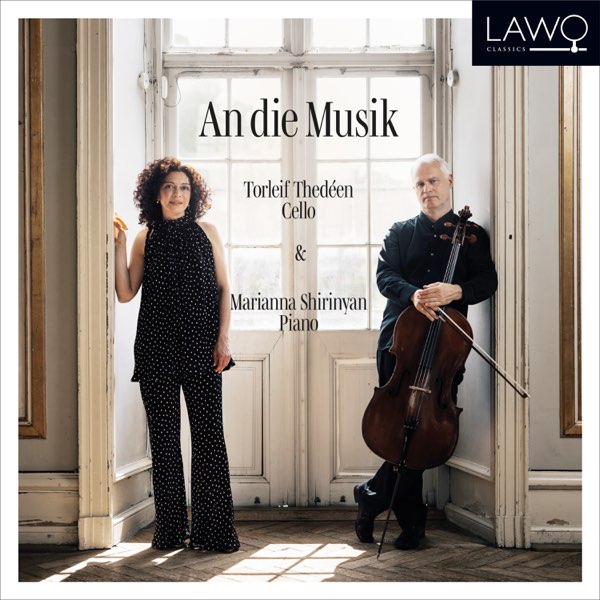In bevlogen spel horen we de Zweedse cellist Torleif Thedéen en de Armeense pianiste Marianna Shirinyan op hun album An die Musik.
English version below
Het is altijd een avontuurlijk spel wanneer musici klassieke werken arrangeren en bewerken tot ‘nieuw’ repertoire. Voor de purist een hel maar voor de avontuurlijke luisteraar een uitdaging. Er worden andere luisteraars bereikt doordat klassieke werken in een nieuwe uitvoering een fris elan krijgen, waardoor er ook luisteraars worden bereikt die anders niet, of minder, in aanraking zouden komen met klassiek repertoire.
Zo is de Schilderijententoonstelling van Moessorgski in 1971 bewerkt en uitgevoerd door Emerson, Lake & Palmer en is Le Sacre du Prinetemps (Stravinsky) zelfs bewerkt voor sologitaar door Larry Coryell. En dan natuurlijk de groep Ekseption die werken van Mozart, Beethoven, Gershwin en Bach op geheel eigen wijze en met succes speelde in de jaren ’70 en ’80.
Op het album An die Musik, van het duo Torleif Thedéen & Marianna Shirinyan, blijft de muziek dichter bij het origineel. In bewerkingen voor cello en piano door Thedéen, voert het duo werken uit van Brahms, Clara en Robert Schumann, Schubert. Met uitzondering van de Cellosonate OP. 6 van Richard Strauss, die door de componist ook voor cello en piano is gecomponeerd.
Het resultaat is het prachtige An die Musik, inderdaad: Voor de Muziek. Welluidende muziek die met veel elan en verve wordt uitgevoerd. In een orkestrale aanpak klinken bevlogen uitvoeringen, zoals Brahm’s openingswerk Scherzo, waar cello en piano elkaar empathisch volgen in snel wisselende stemmingen. Iets soortgelijks horen we in het IIde deel van Clara Schumann’s Romance OP. 22, waar beiden instrumenten elkaar fraai imiteren in gelijke articulatie. De muziek wordt vertelt, klinkt verzorgd en wint in diepgang door de rust en zekerheid die de muziek uitstraalt, zoals in Robert Schumann’s Viool Sonate No. 1 OP. 105 met prachtig welluidende thematiek en virtuoze arpeggio’s in het IIIde deel.
Het lied An die Musik van Schubert uit 1817 is een rustpunt op het album. In deze ode aan de muziek, deze ode aan de kunst, is duidelijk hoorbaar hoe dicht de cello bij de menselijke stem ligt, wat wordt voortgezet in Nacht und Traume, ook van Schubert, waarin de contemplatie van de nacht wordt geëerbiedigd. Werkelijk wonderschoon uitgevoerd door Torleif Thedéen en Marianna Shirinyan!
Daarna volgt de drie-delige Cello Sonate op. 6 van Strauss, die hij componeerde toen hij 19 jaar oud was. Een werk dat met recht tot het standaard cello-piano-repertoire is gaan behoren en dat met zijn rijke muzikale invalshoeken, virtuoos wordt uitgevoerd door deze twee bijzondere musici.
English version
In passionate playing we hear the Swedish cellist Torleif Thedéen and the Armenian pianist Marianna Shirinyan on their album An die Musik.
It is always adventurous when musicians arrange and adapt classical works into ‘new’ repertoire. For the purist it is hell, but for the adventurous listener it is a challenge. Moreover, other listeners are reached by giving classical works a fresh impetus in a new performance, which also reaches listeners who would otherwise not, or less, come into contact with classical repertoire.
For example, Mussorgsky’s Pictures at an Exhibition, which was adapted and performed by Emerson, Lake & Palmer in 1971 and Le Sacre du Prinetemps (Stravinsky) was even adapted for solo guitar by Larry Coryell. And then of course the Dutch group Ekseption, who successfully played works by Mozart, Beethoven, Gershwin and Bach in their own unique way in the 1970s and 1980s.
On the album An die Musik, by the duo Torleif Thedéen & Marianna Shirinyan, the music stays closer to the original. In arrangements for cello and piano by Thedéen, the duo performs works by Brahms, Clara and Robert Schumann, Schubert. With the exception of the Cello Sonata OP. 6 by Richard Strauss, which was originaly composed for cello and piano by the composer.
The result is the wonderful An die Musik, indeed: For the Music. Well-sounding music that is performed with great verve and attention. In an orchestral approach, these performances are inspiring, such as Brahm’s opening work Scherzo, where cello and piano empathetically follow each other in rapidly changing moods. We hear something similar in the 2nd part of Clara Schumann’s Romance OP. 22, where both instruments beautifully imitate each other in equal articulation. The music sound like a story, sounds well-cared for and gains depth through the peace and certainty that the music radiates, as in Robert Schumann’s Violin Sonata No. 1 OP. 105, with beautiful melodious themes and virtuoso arpeggios in the 3rd movement.
The song An die Musik by Schubert from 1817 is a resting point on the album. In this ode to music, this ode to art, it is clearly audible how close the cello is to the human voice, which is continued in Nacht und Traume, also by Schubert, in which the contemplation of the night is honored. Truly wonderfully performed by Torleif Thedéen and Marianna Shirinyan!
This is followed by the three-part Cello Sonata op. 6 by Strauss, which he composed when he was 19 years old. A work that has rightly become part of the standard cello-piano repertoire and that, with its rich musical perspectives, is performed with virtuosity by these two excellent musicians.
- Torleif Thedéen & Marianna Shirinyan: An die Musik (Lawo records)
© Mattie Poels.


Geen reacties